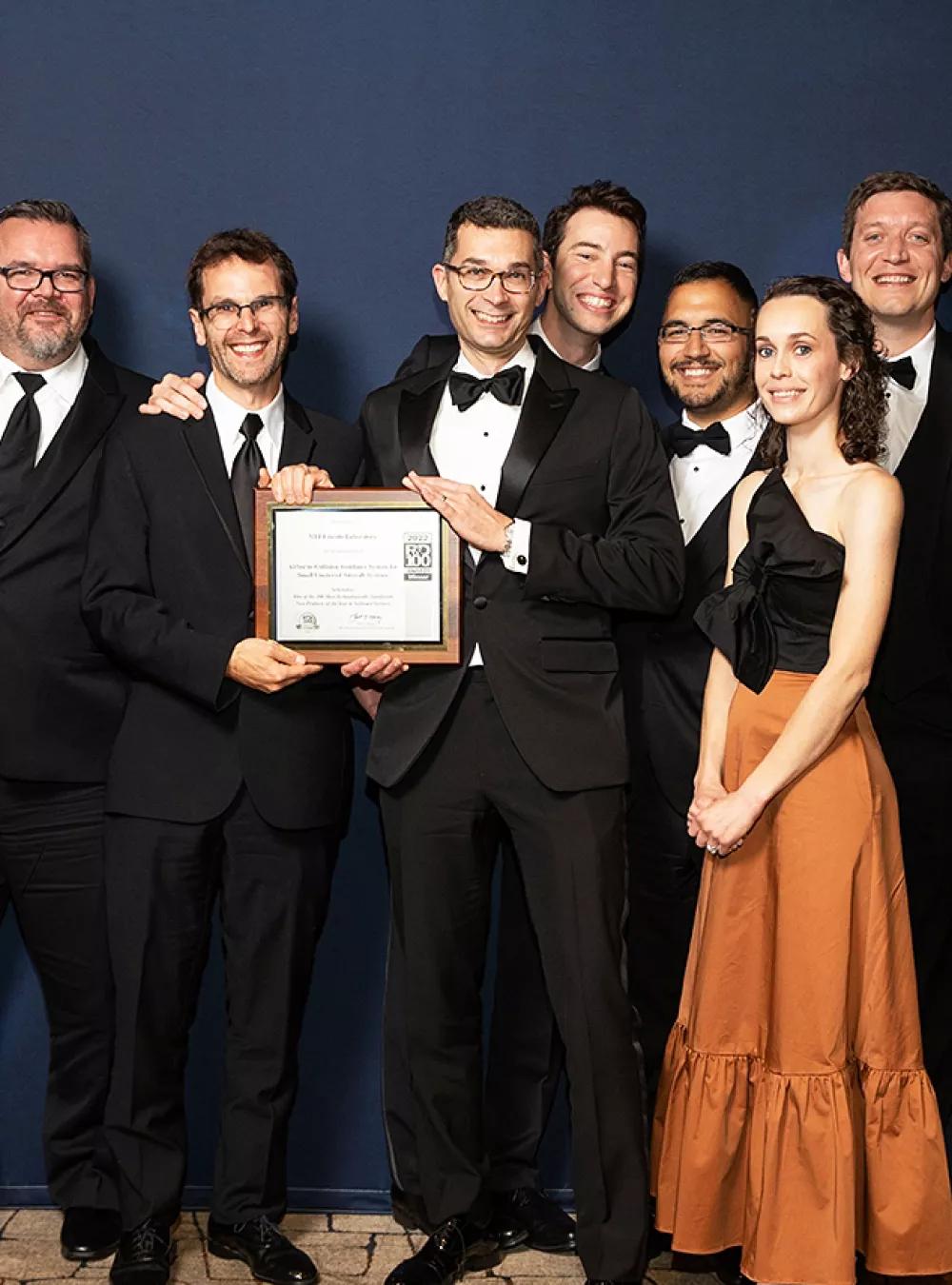MITRE and our partners created and tested a new airborne collision avoidance system, advancing critical innovation to further the development of uncrewed aircraft systems and earning a prestigious R&D100 innovation award.

Preventing Mid-Air Collisions Earns Drone Team Prestigious Award
Above, the team behind the new collision avoidance technology shows off their award at the R&D 100, an event often called "the Oscars of Innovation."
Contained within U.S. aviation law is an important legal necessity: All flying objects—cargo planes, commercial airliners, private jets—need to have the ability to avoid colliding with other flying objects.
This poses a unique problem when it comes to the latest type of vehicle to populate our skies: small uncrewed aircraft systems, also called drones or UAVs. These UAVs can range from small rotorcraft just a few inches wide that can turn on a dime, up to large high-flying drones that maneuver more like a passenger jet. Creating a collision avoidance system that can handle the entire spectrum poses an extraordinary challenge.
Now, a team of FFRDC operators, including MITRE, MIT Lincoln Laboratory, and Johns Hopkins University Applied Physics Laboratory, has found a solution to help the Federal Aviation Administration (FAA) tackle this problem. For their achievement, they’ve won an R&D 100 award.
Creating Systems to Prevent Mid-Air Collisions
Since 1955, the FAA has been focused on creating and improving collision avoidance systems. MITRE’s Center for Advanced Aviation System Development (CAASD), along with MIT’s Lincoln Laboratory and others, has been pivotal in crafting this history. In 1981, MITRE worked closely with the FAA and others to develop and launch the Traffic Collision Avoidance System (TCAS) commercial airlines use today.
With the addition of small planes, commercial space travel, UAVs, and an increase in commercial transport, the National Airspace System (NAS) has gotten more crowded and complex. TCAS, however, was only designed to work with larger private, military, and commercial aircraft.
So the FAA is developing a new approach that could incorporate all the new airspace users: the Advanced Collision Avoidance System (ACAS).
“TCAS, while a good system, is limited in what it can do and doesn’t expand very well,” says MITRE engineer Brian Patterson. “ACAS covers everything the old system has been plus more.”
Versions of ACAS have already been developed for commercial aircraft (ACAS Xa), large drones like those used by the military (ACAS Xu), and one for helicopters (ACAS Xr) is in development. But small unmanned vehicles still posed a significant problem.
To address this, the team developed a new system variant known as ACAS sXu, which allows the UAV to detect and track other nearby aircraft and either maneuver out of the way or communicate the threat to a pilot operator on the ground.
The system uses two distinct parts. First, a surveillance and tracking module brings in information about other flying objects, including their location, size, and trajectory. Then, a threat resolution module uses that data to plan and execute potential evasive maneuvers.
It's gratifying to see organizations working with the FAA to make sure that the airspace, not just here but around the world, is safe for the flying public.
MITRE Engineers Ensure the Safety of the National Airspace
As with any new system, the question was, would it work? Could the new system improve the safety and reliability of the airspace? Part of MITRE's role in the collaboration was to find out.
“One of MITRE’s key strengths is safety risk management—providing that subject matter expertise and doing those human studies,” says Wes Olsen, group leader for the project at Lincoln Laboratory.
MITRE has conducted independent safety assessments of every part of the collision avoidance spectrum, from helicopters to military drones and even small passenger planes.
Using detailed computer models and flight data, MITRE can test whether the system will operate safely before it ever gets into the field.
“It's gratifying to see these organizations working together with the FAA to make sure that the airspace not just here, but around the world is safe for the flying public,” Olsen adds.
So, when will you be able to load this system onto your own drone and take it for a spin?
Unfortunately, it will still be a little while. The ACAS sXu design standard was finalized in late 2022, and the FAA is still developing policy and procedures for manufacturers.
But we’re one step closer to safer skies for small drones and fulfilling MITRE’s core mission: solving problems for a safer world.
Join our diverse community of innovators, learners, knowledge-sharers, and risk takers. View our Job Openings.